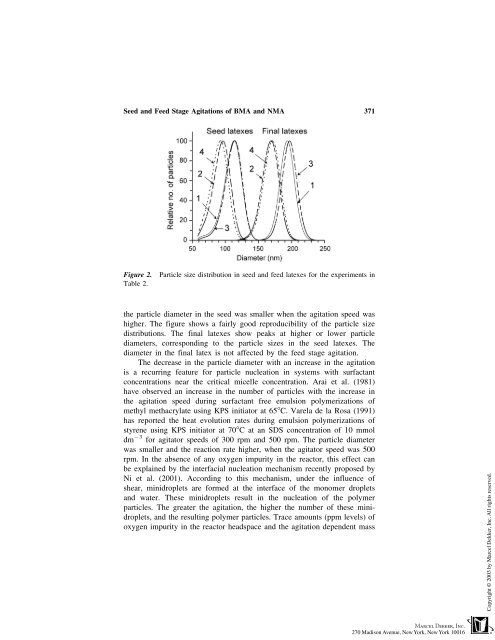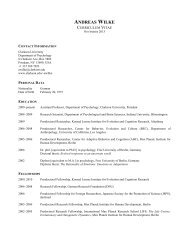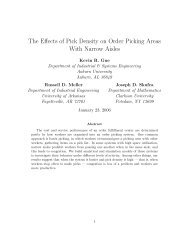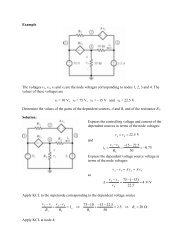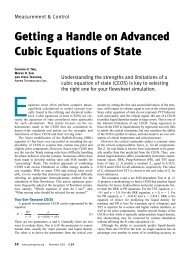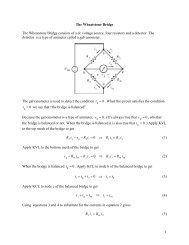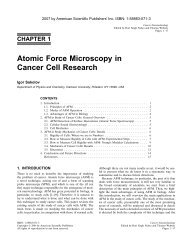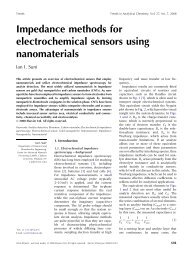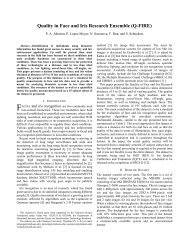Relative Importance of the Effects of Seed and Feed Stage ...
Relative Importance of the Effects of Seed and Feed Stage ...
Relative Importance of the Effects of Seed and Feed Stage ...
Create successful ePaper yourself
Turn your PDF publications into a flip-book with our unique Google optimized e-Paper software.
<strong>Seed</strong> <strong>and</strong> <strong>Feed</strong> <strong>Stage</strong> Agitations <strong>of</strong> BMA <strong>and</strong> NMA 371<br />
Figure 2.<br />
Table 2.<br />
Particle size distribution in seed <strong>and</strong> feed latexes for <strong>the</strong> experiments in<br />
<strong>the</strong> particle diameter in <strong>the</strong> seed was smaller when <strong>the</strong> agitation speed was<br />
higher. The figure shows a fairly good reproducibility <strong>of</strong> <strong>the</strong> particle size<br />
distributions. The final latexes show peaks at higher or lower particle<br />
diameters, corresponding to <strong>the</strong> particle sizes in <strong>the</strong> seed latexes. The<br />
diameter in <strong>the</strong> final latex is not affected by <strong>the</strong> feed stage agitation.<br />
The decrease in <strong>the</strong> particle diameter with an increase in <strong>the</strong> agitation<br />
is a recurring feature for particle nucleation in systems with surfactant<br />
concentrations near <strong>the</strong> critical micelle concentration. Arai et al. (1981)<br />
have observed an increase in <strong>the</strong> number <strong>of</strong> particles with <strong>the</strong> increase in<br />
<strong>the</strong> agitation speed during surfactant free emulsion polymerizations <strong>of</strong><br />
methyl methacrylate using KPS initiator at 65°C. Varela de la Rosa (1991)<br />
has reported <strong>the</strong> heat evolution rates during emulsion polymerizations <strong>of</strong><br />
styrene using KPS initiator at 70°C at an SDS concentration <strong>of</strong> 10 mmol<br />
dm 3 for agitator speeds <strong>of</strong> 300 rpm <strong>and</strong> 500 rpm. The particle diameter<br />
was smaller <strong>and</strong> <strong>the</strong> reaction rate higher, when <strong>the</strong> agitator speed was 500<br />
rpm. In <strong>the</strong> absence <strong>of</strong> any oxygen impurity in <strong>the</strong> reactor, this effect can<br />
be explained by <strong>the</strong> interfacial nucleation mechanism recently proposed by<br />
Ni et al. (2001). According to this mechanism, under <strong>the</strong> influence <strong>of</strong><br />
shear, minidroplets are formed at <strong>the</strong> interface <strong>of</strong> <strong>the</strong> monomer droplets<br />
<strong>and</strong> water. These minidroplets result in <strong>the</strong> nucleation <strong>of</strong> <strong>the</strong> polymer<br />
particles. The greater <strong>the</strong> agitation, <strong>the</strong> higher <strong>the</strong> number <strong>of</strong> <strong>the</strong>se minidroplets,<br />
<strong>and</strong> <strong>the</strong> resulting polymer particles. Trace amounts (ppm levels) <strong>of</strong><br />
oxygen impurity in <strong>the</strong> reactor headspace <strong>and</strong> <strong>the</strong> agitation dependent mass


